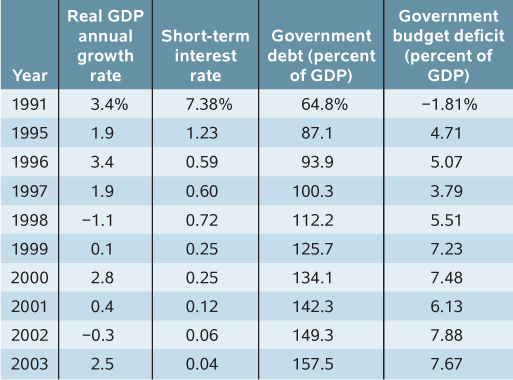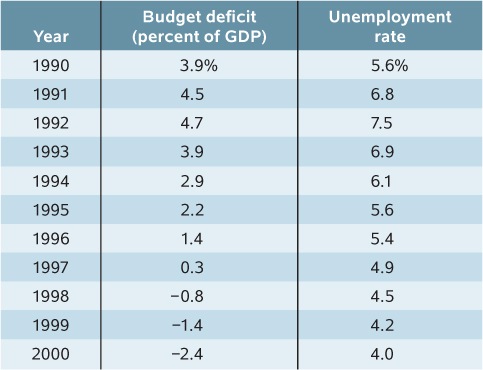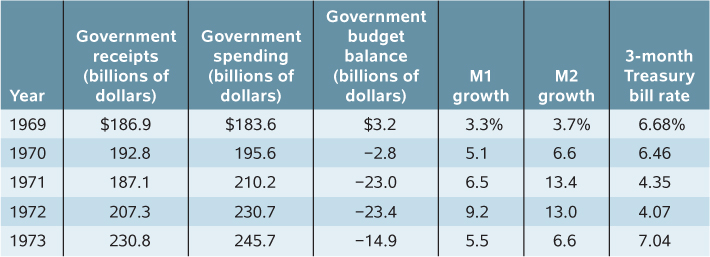Problems
1.After the crash of its stock market in 1989, the Japanese economy saw little economic growth and some deflation. The accompanying table from the Organization for Economic Co-
- From the data, determine the type of policies Japan’s policy makers undertook at that time to promote growth.
- We can safely consider a short-
term interest rate that is less than 0.1% to effectively be a 0% interest rate. What is this situation called? What does it imply about the effectiveness of monetary policy? Of fiscal policy?

2.The National Bureau of Economic Research (NBER) maintains the official chronology of past U.S. business cycles. Go to its website at http:/
- How many business cycles have occurred since the end of World War II in 1945?
- What was the average duration of a business cycle when measured from the end of one expansion (its peak) to the end of the next? That is, what was the average duration of a business cycle in the period from 1945 to 2001?
- When was the last announcement by the NBER’s Business Cycle Dating Committee, and what was it?
3.The fall of America’s military rival, the Soviet Union, in 1989 allowed the United States to significantly reduce its defense spending in subsequent years. Using the data in the following table from the Economic Report of the President, replicate Figure 83-2 for the 1990–

4.In the modern world, central banks are free to increase or reduce the money supply as they see fit. However, some people harken back to the “good old days” of the gold standard. Under the gold standard, the money supply could expand only when the amount of available gold increased.
- Under the gold standard, if the velocity of money were stable when the economy was expanding, what would have had to happen to keep prices stable?
- Why would modern macroeconomists consider the gold standard a bad idea?
5.Monetarists believed for a period of time that the velocity of money was stable within a country. However, with financial innovation, the velocity began shifting around erratically after 1980. As would be expected, the velocity of money is different across countries depending upon the sophistication of their financial systems—

- Calculate the velocity of money for each of the countries. The accompanying table shows an example of a single year’s GDP per capita data for each of these countries in U.S. dollars.

- Rank the countries in descending order of per capita income and velocity of money. Do wealthy countries or poor countries tend to “turn over” their money more times per year? Would you expect wealthy countries to have more sophisticated financial systems?
6.Kenneth Rogoff proclaimed Richard Nixon “the all-

7.The economy of Albernia is facing a recessionary gap, and the leader of that nation calls together five of its best economists representing the classical, Keynesian, monetarist, real business cycle, and Great Moderation consensus views of the macroeconomy. Explain what policies each economist would recommend and why.
8.Which of the following policy recommendations are consistent with the classical, Keynesian, monetarist, and/or Great Moderation consensus views of the macroeconomy?
- Since the long-
run growth of GDP is 2%, the money supply should grow at 2%. - Decrease government spending in order to decrease inflationary pressure.
- Increase the money supply in order to alleviate a recessionary gap.
- Always maintain a balanced budget.
- Decrease the budget deficit as a percent of GDP when facing a recessionary gap.
9.Using a graph like Figure 83-3, show how a monetarist can argue that a contractionary fiscal policy need not lead to a fall in real GDP given a fixed money supply. Explain.
 www.worthpublishers.com/
www.worthpublishers.com/